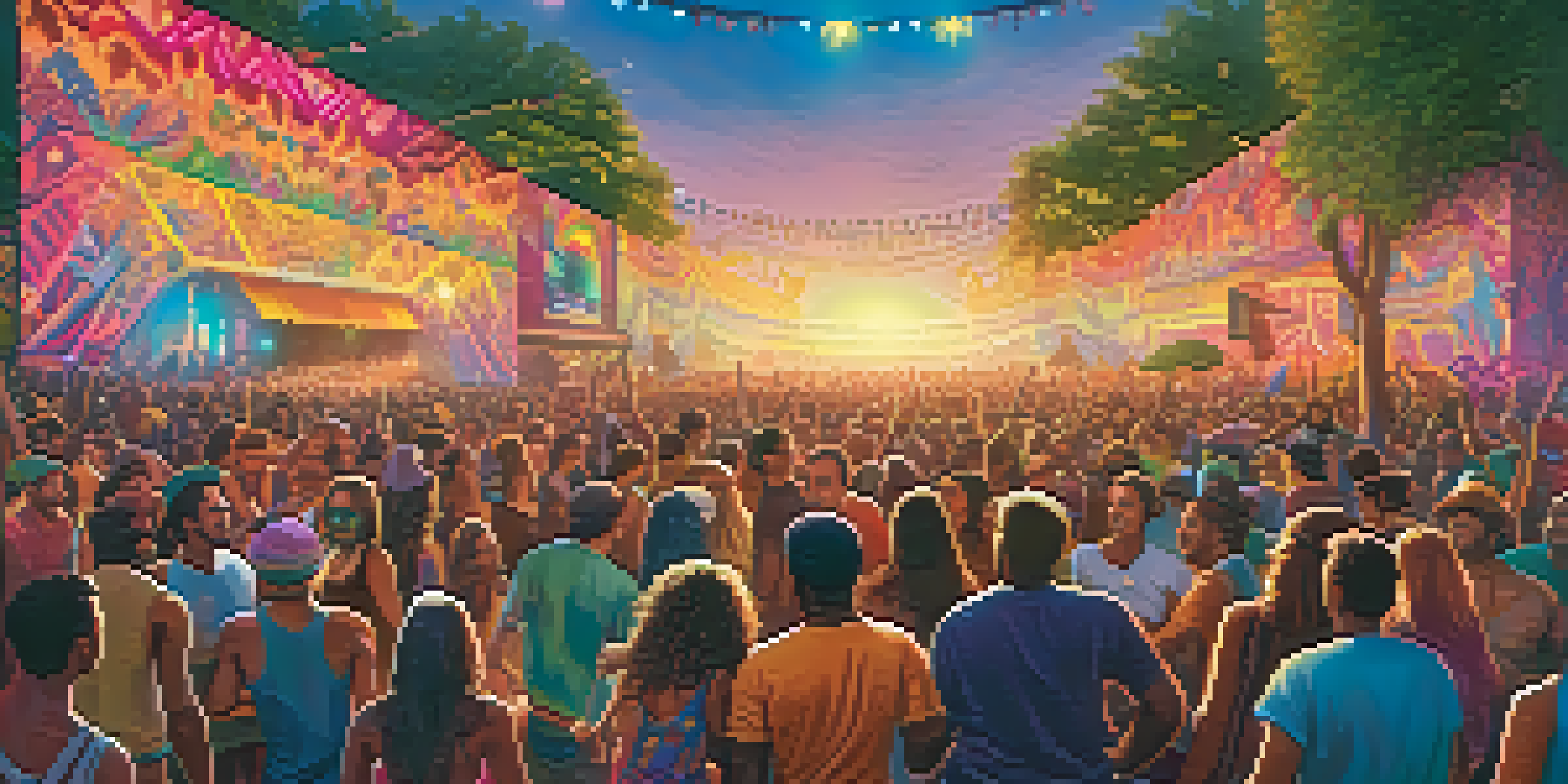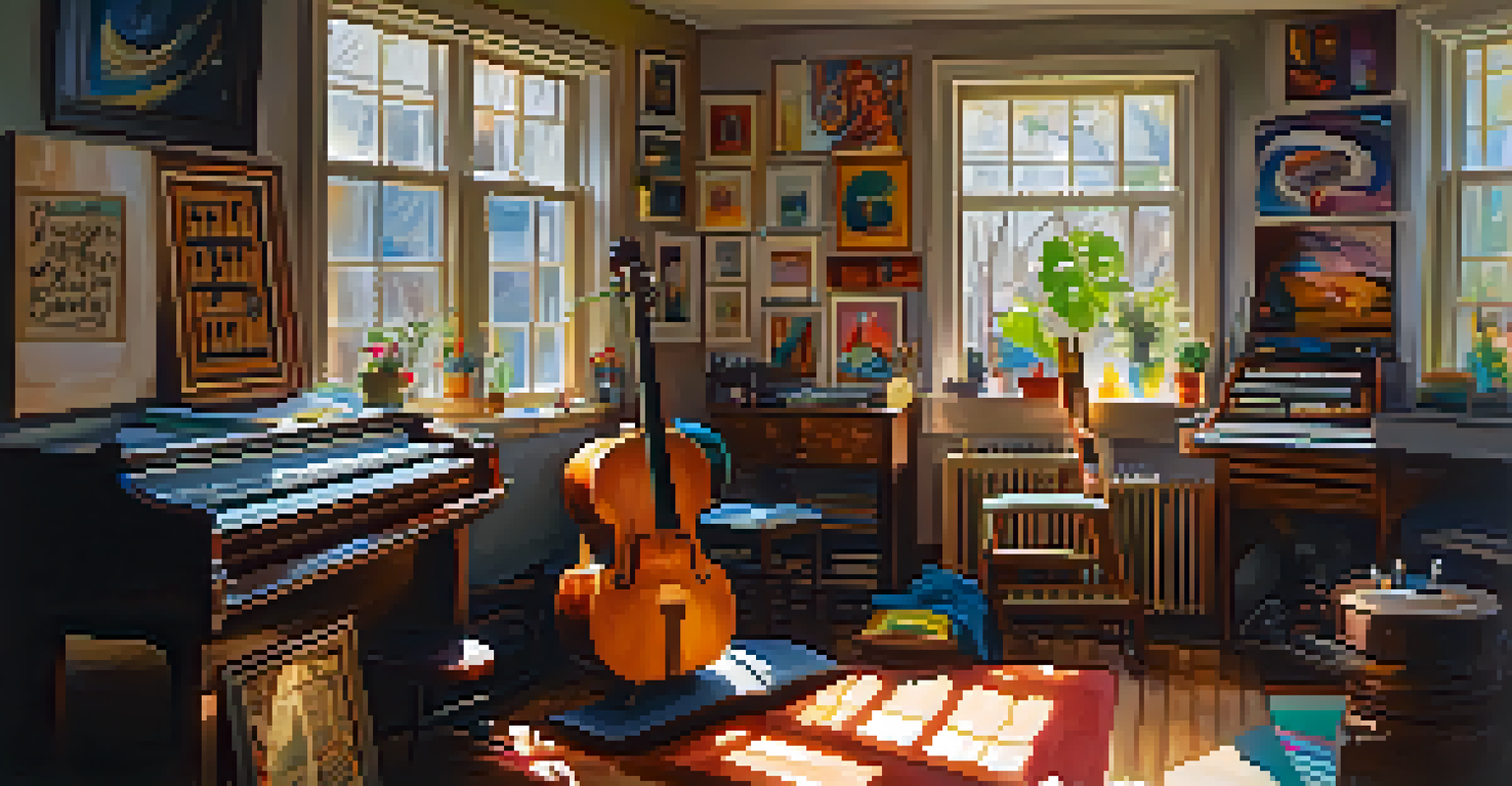Entheogens and Spiritual Journeys in Popular Music

Understanding Entheogens: The Basics and Beyond
Entheogens are substances that induce altered states of consciousness, often used in spiritual or religious contexts. These can include natural plants like peyote or psilocybin mushrooms, which have been utilized for centuries in various cultures. The term 'entheogen' comes from Greek roots meaning 'generating the divine within,' highlighting their role in spiritual exploration.
Psychedelics have a way of making you feel like you're connected to everything, like you're part of a greater whole.
In popular music, artists often draw inspiration from these experiences, channeling their insights into their work. This connection between music and spirituality can lead to profound emotional and psychological impacts on listeners. By incorporating themes related to entheogens, musicians provide a unique lens through which audiences can explore their own spiritual journeys.
As the world becomes more open to discussing mental health and spirituality, the role of entheogens in music continues to evolve. They serve as a bridge between traditional practices and contemporary artistic expression, making the exploration of consciousness accessible to a wider audience.
The Psychedelic Era: Music and Mind Expansion
The 1960s marked a turning point in popular music, with the rise of psychedelic rock, heavily influenced by entheogenic experiences. Bands like The Beatles and The Doors used these substances to expand their musical and lyrical horizons, resulting in iconic albums that still resonate today. Songs like 'Lucy in the Sky with Diamonds' exemplify the vivid imagery and altered perceptions that accompany psychedelic experiences.

Musicians of this era often sought to capture the essence of their journeys through sound, using innovative techniques and experimental structures. This not only pushed the boundaries of music but also encouraged listeners to explore their own consciousness. The intertwining of music and entheogens led to a cultural shift, where self-discovery and spiritual exploration became central themes.
Entheogens Shape Music's Spirituality
Entheogens have historically influenced music by providing artists with profound insights that inspire spiritual and emotional themes in their work.
The legacy of the psychedelic era continues to influence modern artists, who draw upon these experiences to craft their own narratives. From Tame Impala to MGMT, contemporary musicians are unafraid to explore the depths of the human psyche, creating music that invites listeners on a transformative journey.
Spiritual Themes in Lyrics: A Deep Dive
Lyrical content in popular music often reflects spiritual themes, and entheogens can play a significant role in shaping these narratives. Artists like Jimi Hendrix and Bob Marley incorporated elements of spirituality, using their music as a platform to share insights gained from their experiences. Their lyrics often explore concepts of unity, transcendence, and self-discovery, resonating deeply with listeners.
One good thing about music, when it hits you, you feel no pain.
Take, for example, Marley's 'One Love,' which speaks to a collective consciousness and the importance of togetherness. This song embodies the idea of seeking a higher purpose and connection, much like the experiences facilitated by entheogens. By weaving these themes into their music, artists create a space for listeners to reflect on their own spiritual journeys.
The ability of lyrics to evoke such profound feelings showcases the power of music as a tool for spiritual exploration. Whether it’s through metaphor or direct experience, these songs become vehicles for listeners to engage with their own spirituality and search for meaning.
Modern Artists Embracing Entheogenic Inspiration
In recent years, a new wave of artists has emerged, openly discussing their experiences with entheogens. Figures like Billie Eilish and Lana Del Rey have incorporated themes of spiritual awakening and self-exploration into their music, resonating with a generation seeking authenticity and connection. Their willingness to share these experiences encourages fans to engage in their own spiritual journeys.
These artists often blend personal narratives with broader themes, making their music relatable and meaningful. Songs like Eilish's 'When the Party's Over' evoke feelings of introspection and emotional vulnerability, creating a safe space for listeners to explore their own thoughts and emotions. This connection between personal experience and universal themes is a hallmark of contemporary music.
Psychedelic Era Revolutionized Music
The 1960s psychedelic rock movement, led by bands like The Beatles, embraced entheogenic experiences, pushing musical boundaries and encouraging self-exploration among listeners.
As society continues to shift towards acceptance of entheogens, artists are likely to explore these themes even further. The dialogue around mental health, spirituality, and creativity is becoming increasingly relevant, offering a rich tapestry for musicians to draw from in their work.
The Role of Music Festivals in Spiritual Exploration
Music festivals have become a cultural phenomenon, serving as gathering places for like-minded individuals exploring spirituality and consciousness. Events like Burning Man and Coachella often feature artists whose work is influenced by entheogens, creating a unique atmosphere for personal and communal exploration. These festivals offer a platform for attendees to immerse themselves in music, art, and spiritual experiences.
The environment at these festivals encourages open-mindedness and self-discovery, allowing participants to connect deeply with themselves and others. Many festival-goers report transformative experiences, often enhanced by the music and the presence of entheogens. This sense of community and shared exploration can lead to lasting connections and personal growth.
As more people seek out these experiences, the intersection of music festivals and spiritual journeys will only continue to grow. The blend of creative expression and personal exploration is a powerful force, shaping the way we understand and engage with our own spirituality.
Cultural Perspectives: Entheogens Across the Globe
Entheogens have been used in various cultures around the world for centuries, often serving as sacred tools for spiritual connection. From the Amazonian shamans using ayahuasca to Native American rituals involving peyote, these substances are integral to many indigenous practices. The global perspective on entheogens highlights their diverse roles in fostering spiritual experiences.
In popular music, many artists draw inspiration from these cultural traditions, integrating them into their work. By doing so, they not only acknowledge the rich history of these substances but also create a dialogue around their potential for healing and self-discovery. This cultural exchange enriches the music and encourages a broader understanding of entheogens.
Festivals Foster Spiritual Connection
Music festivals serve as communal spaces for spiritual exploration, where artists and attendees alike engage in transformative experiences often enhanced by entheogens.
As the conversation around entheogens becomes more mainstream, it’s essential to approach these topics with respect and understanding. Acknowledging the cultural significance of these substances can lead to more meaningful discussions and experiences, both in music and beyond.
The Future of Music and Spiritual Exploration
As we look to the future, the relationship between music and spirituality is expected to evolve further. With a growing acceptance of entheogens and their potential benefits, artists will likely continue to explore these themes in innovative ways. This evolution may lead to new genres and movements that prioritize spiritual growth and self-exploration.
Moreover, the rise of technology and digital platforms allows for greater accessibility to diverse musical experiences. Artists are now able to share their journeys and insights with a global audience, fostering a sense of community among those seeking spiritual connection through music. This interconnectedness can amplify the impact of their messages and inspire listeners worldwide.

Ultimately, the fusion of entheogens and popular music will continue to inspire personal and collective spiritual journeys. As artists delve deeper into these themes, they create a rich tapestry of sound and meaning that encourages listeners to explore their own paths of self-discovery.